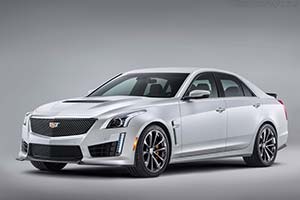
| Cadillac CTS-V |
| Article | Image gallery (17) | Specifications |

|
|
<< Prev Page 2 of 3 Next >> The supercharger's rotors are smaller in diameter than the previous supercharged engine, allowing higher maximum rpm that enables power-enhancing boost to be generated earlier in the rpm band. That boost is achieved more efficiently via a more direct discharge port that creates less turbulence, reducing heat and speeding airflow into the engine. The Cadillac supercharged engine also has several unique features designed to support its high output and the greater cylinder pressures created by forced induction, including Rotocast A356T6 aluminum cylinder heads that are stronger and handle heat better than conventional aluminum heads, and lightweight titanium intake valves. The CTS-V's complementing eight-speed automatic is tuned for world-class shift-response times. Smaller steps between gears keep the engine within the sweet spot of the rpm band, making the most of the output of the supercharged engine for exhilarating performance and greater efficiency. The new 8L90 transmission offers full manual control via steering wheel paddles, and Performance Algorithm Shifting to deliver shift performance that rivals the dual-clutch/semi-automatic transmissions found in many luxury performance sedans - but with the smoothness and refinement that come with a conventional automatic fitted with a torque converter. The CTS's structure is highly mass optimized and designed to meet higher performance requirements, with enhancements to the V-Series developed to respond to cornering and torque loads that significantly exceed the levels experienced by the non-V models. Unique and revised elements include:
"With the stronger body structure - and more than a decade of V-Series production models and the CTS-V racing program experience - engineers tuned the CTS-V to deliver greater body motion control for a more agile feel, while maintaining excellent ride quality," said David Leone, Cadillac executive chief engineer. "The result is class-leading capability on the highway or track, balanced with luxury and refinement." The CTS-V shares the same 114.6-inch (2,910 mm) wheelbase as the CTS non-V-Series models, but has wider front and rear footprints that enhance grip, reduce body motion and contribute to more direct-feeling steering. Nineteen-inch wheels wrapped with specially developed Michelin Pilot Super Sport tires give the CTS-V its footprint and enable nearly 1g in lateral acceleration. The lightweight, forged aluminum wheels - measuring 9.5 inches wide in the front and 10 inches wide in the rear - are constructed of a low-mass forging that helps reduce un-sprung weight for greater agility and a more direct feel to steering inputs. The wheels are 45-percent stiffer than previous CTS-V wheels, while the Michelin tires feature a tri-compound tread that delivers excellent grip in performance driving situations, while offering excellent ride quality characteristics and extended tread wear. Additional contributors to the CTS-V's responsive, connected and track-capable driving experience include:
Magnetic Ride Control "reads" the road a thousand times per second, sending data to magneto-rheological fluid-filled dampers that can independently control the damping characteristics of all four dampers. Third-generation improvements enable 40-percent faster damping response. At 60 mph, the third-generation magnetic ride control system calculates the optimal damping force for every inch of the road. << Prev Page 2 of 3 Next >> |
| Article | Image gallery (17) | Specifications |
| All Cars - Contact us - Privacy Statement - Top | © 1998 - 2024 Ultimatecarpage.com |

